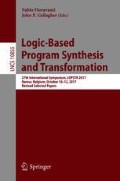Abstract
Unification and generalization are operations on two terms computing respectively their greatest lower bound and least upper bound when the terms are quasi-ordered by subsumption up to variable renaming (i.e., \(t_1\preceq t_2\) iff \(t_1=t_2\sigma \) for some variable substitution \(\sigma \)). When term signatures are such that distinct functor symbols may be related with a fuzzy equivalence (called a similarity), these operations can be formally extended to tolerate mismatches on functor names and/or arity or argument order. We reformulate and extend previous work with a declarative approach defining unification and generalization as sets of axioms and rules forming a complete constraint-normalization proof system. These include the Reynolds-Plotkin term-generalization procedures, Maria Sessa’s “weak” unification with partially fuzzy signatures and its corresponding generalization, as well as novel extensions of such operations to fully fuzzy signatures (i.e., similar functors with possibly different arities). One advantage of this approach is that it requires no modification of the conventional data structures for terms and substitutions. This and the fact that these declarative specifications are efficiently executable conditional Horn-clauses offers great practical potential for fuzzy information-handling applications.
This article appears in the pre-proceedings of LOPSTR 2017 with the title “Lattice Operations on Terms over Similar Signatures.” Its new title is technically more accurate. All proofs and more examples can be found in a more detailed paper [2]. This work is part of a wider study [3].
Access this chapter
Tax calculation will be finalised at checkout
Purchases are for personal use only
Notes
- 1.
We shall use Prolog’s convention of writing variables with capitalized symbols.
- 2.
When \(\mathbf{arity }(f)=n\), this is often denoted by writing f / n.
- 3.
Such as the Herbrand-Martelli-Montanari unification rules w.r.t. to Robinson’s procedural unification algorithm.
- 4.
- 5.
See Case (2) of the weak unification algorithm given in [17], Page 413.
- 6.
Quasi-linear; i.e., linear with a \(\log \ldots \log \) coefficient [1].
References
Aho, A., Hopcroft, J., Ullmann, J.: The Design and Analysis of Computer Algorithms. Addison-Wesley, Reading (1974)
Aït-Kaci, H., Pasi, G.: Fuzzy lattice operations on first-order terms over signatures with similar constructors. Journal Submission Preprint (2017). http://hassan-ait-kaci.net/pdf/fuzfotlat-preprint.pdf
Aït-Kaci, H., Pasi, G.: Fuzzy lattice-theoretic operations over data and knowledge structures. Technical report, HAK Language Technologies (2017, in preparation). http://hassan-ait-kaci.net/pdf/fuzlatopdks.pdf
Aït-Kaci, H., Podelski, A., Goldstein, S.C.: Order-sorted feature theory unification. J. Logic Program. 30(2), 99–124 (1997). http://www.hassan-ait-kaci.net/pdf/osf-theory-unification.pdf
Aït-Kaci, H., Podelski, A., Goldstein, S.C.: Order-sorted feature theory unification. J. Logic Program. 30(2), 99–124 (1997). www.hassan-ait-kaci.net/pdf/ecml01.pdf
Baziz, M., Boughanem, M., Pasi, G., Prade, H.: A fuzzy set approach to concept-based information retrieval. In: Montseny, E., Sobrevilla, P. (eds.) Proceedings of the Joint 4th Conference of the European Society for Fuzzy Logic and Technology, Barcelona, Spain, pp. 1287–1292, 7–9 September 2005. https://www.irit.fr/publis/ADRIA/BougPetal001a.pdf
Dubois, D., Prade, H.: Fuzzy sets and systems: theory and applications. In: Ames, W.F. (ed.) Mathematics in Science and Engineering, Georgia Institute of Technology, vol. 144. Academic Press (1980). ftp://ftp.micronet-rostov.ru/linux-support/books/computer%20science/Fuzzy%20systems/Fuzzy%20Sets%20And%20Systems%20Theory%20And%20Applications%20-%20Didier%20Dubois%20,%20Henri%20Prade.pdf
Herbrand, J.: Recherches sur la théorie de la démonstration. Ph.D. thesis, Faculté des sciences de l’université de Paris, Paris, France (1930)
Jaffar, J.: Efficient unification over infinite terms. New Gener. Comput. 2(3), 207–219 (1984). https://link.springer.com/article/10.1007/BF03037057
Julián-Iranzo, P., Rubio-Manzano, C.: A similarity-based WAM for Bousi Prolog. In: Cabestany, J., Sandoval, F., Prieto, A., Corchado, J.M. (eds.) IWANN 2009. LNCS, vol. 5517, pp. 245–252. Springer, Heidelberg (2009). https://doi.org/10.1007/978-3-642-02478-8_31
Knight, K.: Unification: a multidisciplinary survey. ACM Comput. Surv. 21(1), 93–124 (1989). http://citeseerx.ist.psu.edu/viewdoc/download;jsessionid=92AF7CA745E2C0B8EB619F09FFB5D3CA?doi=10.1.1.64.8967&rep=rep1&type=pdf
Lacoste-Julien, S., Palla, K., Davies, A., Kasneci, G., Graepel, T., Ghahramani, Z.: SiGMa: simple greedy matching for aligning large knowledge bases. In: Proceedings of the 19th ACM International Conference on Knowledge Discovery and Data Mining (SIGKDD 2013), Chicago, IL, USA, pp. 572–580. ACM, New York, 11–14 August 2013. http://snap.stanford.edu/social2012/papers/lacostejulien-palla-etal.pdf; see also https://arxiv.org/pdf/1207.4525.pdf
Martelli, A., Montanari, U.: An efficient unification algorithm. ACM Trans. Program. Lang. Syst. 4(2), 258–282 (1982). http://moscova.inria.fr/levy/courses/X/IF/03/pi/levy2/martelli-montanari.pdf
Plotkin, G.D.: Lattice theoretic properties of subsumption. Technical Memo MIP-R-77, Department of Machine Intelligence and Perception, University of Edinburgh, Edinburgh, Scotland, UK, June 1970
Plotkin, G.D.: A note on inductive generalization. In: Metzer, B., Michie, D. (eds.) Machine Intelligence, Chap. 8, vol. 5, pp. 154–163. Edinburgh University Press, Edinburgh (UK) (1970), http://homepages.inf.ed.ac.uk/gdp/publications/MI5_note_ind_gen.pdf
Reynolds, J.C.: Transformational systems and the algebraic nature of atomic formulas. In: Metzer, B., Michie, D. (eds.) Machine Intelligence, Chap. 7, vol. 5, pp. 135–151. Edinburgh University Press, Edinburgh (1970). http://www.cs.cmu.edu/afs/cs/user/jcr/ftp/transysalg.pdf
Sessa, M.I.: Approximate reasoning by similarity-based SLD resolution. Theor. Comput. Sci. 275, 389–426 (2002). http://www.sciencedirect.com/science/article/pii/S0304397501001888
Wayne, K.: Union-find. Tutorial lecture slides based on book “Algorithm Design” by Jon Kleinberg and Éva Tardos. Addison-Wesley (2015). https://www.cs.princeton.edu/wayne/kleinberg-tardos/pdf/UnionFind.pdf
Author information
Authors and Affiliations
Corresponding author
Editor information
Editors and Affiliations
Rights and permissions
Copyright information
© 2018 Springer International Publishing AG, part of Springer Nature
About this paper
Cite this paper
Aït-Kaci, H., Pasi, G. (2018). Fuzzy Unification and Generalization of First-Order Terms over Similar Signatures. In: Fioravanti, F., Gallagher, J. (eds) Logic-Based Program Synthesis and Transformation. LOPSTR 2017. Lecture Notes in Computer Science(), vol 10855. Springer, Cham. https://doi.org/10.1007/978-3-319-94460-9_13
Download citation
DOI: https://doi.org/10.1007/978-3-319-94460-9_13
Published:
Publisher Name: Springer, Cham
Print ISBN: 978-3-319-94459-3
Online ISBN: 978-3-319-94460-9
eBook Packages: Computer ScienceComputer Science (R0)

